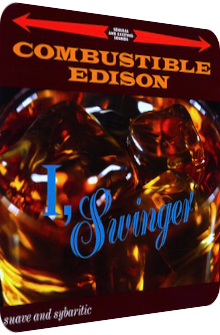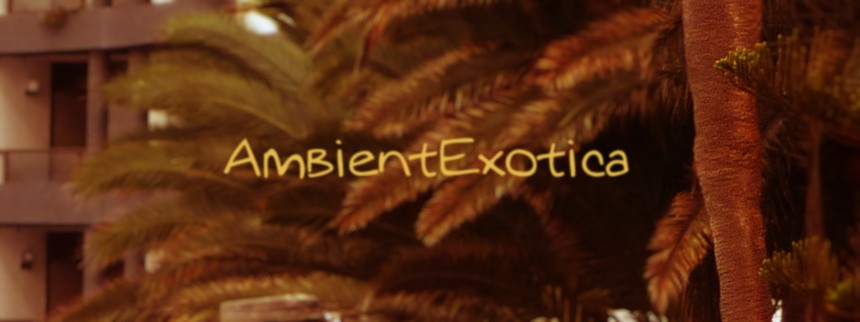
Combustible Edison
I, Swinger
1994
There are so many important Exotica-related works to review, but this one has a particularly relevant history: Combustible Edison is a Providence, Rhode Island-based quintet of musicians interested in Lounge music, Space-Age realms and Latin concoctions. You will find gazillions of other bands that share these interests, but rarely do you find a setup in the early 90's that is so dedicated to the vintage days of Exotica and Surf Rock. The album that features all these tonalities and styles is called I, Swinger, recorded at Watertown, Massachussetts in the Summer of 1993 and released 1994 on the Sub-Pop label.
To draw a quick conclusion of Combustible Edison's foresightful cocktail: they targeted these various styles before iconic movies like Pulp Fiction or The Big Lebowski even officially launched or existed! Incidentally, I, Swinger is possibly best known for the inclusion of three of its tracks on the quirky bellboy movie Four Rooms of 1995. But even if you free this album from any cinematic scope, there is plenty of exotic material to discover. Back in the mid-90's, the band setup consists of vocalist and bongo player Miss Lily Banquette aka Liz Cox, the ominous stage persona and guitarist called The Millionaire aka Michael Cudahy, related bassist Nick Cudahy, Peter Dixon on the organs and Aaron Oppenheimer as the drummer, percussionist and, possibly most importantly, the vibraphonist, as the luminosity of the latter instrument is ubiquitously perceptible.
Their offering of twelve tracks provides a mix of unique compositions with classic material, a scheme which was adapted by most neo-Exotica and Lounge bands that resurrected a few years after Combustible Edison. The driving factor of the album is often dark and murky, and I have not even mentioned the many spy themes the band comes up with. But there are decidedly paradisiac settings on board as well. In the following paragraphs, I will not approach this important work in an overly sedate manner, as the album title clearly forbids to do just that anyway.
The point of departure is reached via a Cadillac, and this assertion would be correct due to the fact that this is a short opening vignette and one of the tunes that has been previously featured on the aforementioned Four Rooms flick. Originally composed by Giovanni "Nino" Rota, the quintet fires off right from the start: a mélange of Nick Cudahy’s cavernous double bass backings, wonky piano stabs and quirky vibraphones make up this comical and instantly recognizable piece which is further accentuated by Dixon’s organ infusion and Michael Cudahy’s steel guitar twangs. Aaron Oppenheimer revs up the percussion at certain points, with the cymbals sounding more icy at many given times. Despite its status of a short opener, this is a highly recognizable tune that towers above each and every fast-paced funny tune of vintage Exotica maestros Martin Denny and Arthur Lyman. A song that is as essential as it is short.
The following The Millionaire’s Holiday meshes Latin lamento mannerisms with organ-fueled spots of colors, surf guitar skeletons and a deliberate laissez-faire attitude of coolness. The hidden sleaziness of Cadillac (Rota) is worked out more distinctly here. Rounded off by Lily Banquette’s sparse xylophone-backed vocals which basically just repeat the title of the ditty, her voice becomes more of an instrument than an actual marker of usable information. Breakfast At Denny’s (is it the Denny? Must be!) is a spot-on faux-Oriental Exotica cut with a flute-like organ mystique, a gelid vibraphone arcaneness, dusky electric guitar underpinnings and sparkling pizzicato violin strings. All these devices evoke the Egyptian procession of a bath ritual. The middle section is especially noteworthy for Michael Cudahy’s electric guitar which oscillates between Sicilian tone sequences and a Middle Eastern oud timbre. Multiplied male voices build a murky choir who gazes lustfully at the scenery. It is an intendedly clichéd song, but created way before the Oriental skits of The Karminsky Experience, which makes it all the more valuable.
While the cheekily titled, almost four minutes long Intermission is a serious percussion-shifting Bossa Nova incarnation loaded with croaking guiros, Balearic guitars, both spectral-cold and sizzling-hot organs plus lushly reverberated vibe droplets, Cry Me A River is a take on Arthur Hamilton’s world-famous smash hit and comprises of Banquette’s film noir-esque vocals which provide an intimate timbre that is slowly changed by the rising tension. The sparse instrumentation of the mellow double bass accents, wafting cymbals and accordion-evoking streams is boosted when the rhythm changes to a fully-fledged 3/4 time scheme that ends with several piano-laden spy theme riffs.
The ensuing Impact! is a big favorite of mine thanks to its concoction of delicately skewed organ riffs, xylophone injections, clicking castanets and an overall chopped cacophony. The darkly hammering pianos kindle the tension, the electric guitar sits in-between the continents. All devices resurrect the quirkiness of Cadillac (Rota), but put it in a totally different and darker context. It’s a splendid theme for dark lounges and has a pre-apocalyptic feel to it. Marvelous! Moving into sunnier realms, Guadaloupe is a vocal track with a phantasmagoric vibraphone polyphony, enigmatic wind chimes, clicking wood sticks and both a Honky Tonk piano and a seriously warm-hearted, much more euphonious next of kin. Lily Banquette’s vocals and high plasticity-bongos, the humming choir as well as the permanent shift between contemplation and glee provide a great listening experience. And a screaming monkey.
Carnival Of Souls is one of Combustible Edison’s better-known tracks. One could even say that it is iconic thanks to its inclusion in the Four Rooms movie. Being played while bellboy Ted falls to the floor in a comatose state of remembrance, the tune juxtaposes ghostly 3/4 time oompa apparitions and freezing-cold Space-Age vibraphone creeks to sun-dried guitar chords and Banquette’s chants in sky-high regions. It is a tremendously strong nocturnal take that suggests a usage at quieter Halloween parties. It is another big favorite of mine. The Veldt is yet another stomper and the pinnacle of the soon to be established pre-neo-Exotica (err?) movement. The band intertwines Radiophonic Workshop birdcalls and tropical soundscapes with a wonderfully mild-mannered luminous piano melody, clarinet-like organ settings and a mellifluous mirage of steel guitar strings which conflate with the plastic jungle. I especially like the focus of the tune: no bludgeoned rhythm shift, no alienating ingredients or witty vocals are to be heard. It is a unique Exotica track in vintage style. So grand!
While the quintet’s take on Kurt Weill’s Surabaya Johnny harks back on Arthur Hamilton’s Cry Me A River and could well be the most-focused and minimal track with not much else than a majestic pianoscape, the wafting glints of the vibes, Banquette’s enchanting vocals and a hyper-dreamy steal guitar ethereality, the hyper-frantic Spy Vs. Spy unleashes, well, spy motifs on the electric guitar, hectic but silky shakers and cymbals as well as an almost ecclesial organ next to the almost mandatory rhythmic changes. The hallmark, though, is the inclusion of a baroque horror B-movie harpsichord, an instrument (or rather synth setting) which hasn’t been used by the band heretofore and expands the instrumental pool with a surprising and fitting note.
The finishing line is approached by a rockier segue full of baneful guitars and classic drum kit performances that lead to the ultimate, best-est, über-powerful Theme From "The Tiki Wonder Hour"! It is based on the 1991 stage show Michael Cudahy wrote. Fans of Four Rooms have encountered this tune in the movie as well, but it is a tad more famous in exclusive (but easy-to-enter) circles nowadays due to the devoted fan base of DigiTiki’s aka Mark Riddle’s Quiet Village Podcast where it splendidly serves as languorous background music. Make no mistake, its status as a great background tune does not degrade its solemnity and soothing setup in the slightest, but is meant as a glaring compliment: the five-note drum aorta meanders through the lush greeneries of Oppenheimer’s rising – and then falling – vibe drops of resplendent bliss, meets with Trisha Matthew’s eight-note fugue on the violin, flows over to the softest of all electric guitars and conflates with the distant drone of further drums. This is one of the best neo-Exotica pieces you will ever come across, inheriting the spirits of the Golden 50’s and Sunset 60's. It is so unlike the majority of the intrinsic material, so balmy and hammock-compatible that I am constantly in awe. It is as if the quintet has found a hidden treasure chest somewhere on a distant Polynesian island with anything in it but the sheet music of this essential tune. A masterpiece as an outro. Such a statement is utterly rare, but entirely in the realm of possibility, as Combustible Edison show.
I, Swinger is a greatly varied and diversified neo-Exotica debut by the band, and the often-reported serious or rather dedicated approach is a boon to this day. The album doesn’t sound dated, not even when the band harks back to the vintage days of the genre. Lounge lizards, Latin lovers and Exotica elders are all targeted and will probably succumb to the glitzy material. Whether you are searching for renditions of classic material, a moon-lit mystique or the thermal heat that vaporizes into Latinized steam, I, Swinger is an important new take of a genre diversity that was to be perturbed by lackluster DJ’s and one too many Lounge skits in the following years. After a period of stylistic cleansing and an ebbed interest, this album is one of the few marvels that survived the club-oriented invasion.
My personal highlights comprise of the gargantuan closing track Theme From »The Tiki Wonder Hour« which is constantly with me when I’m traveling (this includes the path to the kitchen or garden as well!), the ghostly coldness of Carnival Of Souls with its multitude of organ bridges and vibraphone droplets as well as The Veldt with its tropical jungle panorama and truly majestic piano chords. Breakfast At Denny’s reaches a close fourth place, its transformation of aural waves into an Oriental palace is much appreciated and curiously enchanting. Whole albums were formed by other bands with this specific mood intact, so Combustible Edison proved to be on the right track there. The quintet obviously tries to present as wide a genre-related range as possible, but I can only stress the importance of both Combustible Edison and their newly reclaimed land of the Grunge- and Dance-oriented 90’s, and it is thus a wise choice to neglect a too narrow scope and go all-in for variety. Jazz lovers will be fond of the many downbeat and intimate renditions, as Lily Banquette’s vocal range can be cozy, mellifluous and tastefully suggestive at the same time.
If there is one thing missing most of the time, it is a truly blithesome, tremendously convivial or reverie-like take without a bold quirkiness, as the sleazy darkness is usually lurking on each composition. But this emotion isn’t the essential focus of any track, and usually not needed in darker Lounge music anyway. I, Swinger is totally recommended and remains a hyper-modern Exotica album to this day.
Exotica Review 150: Combustible Edison – I, Swinger (1994). Originally published on Nov. 24, 2012 at AmbientExotica.com.
